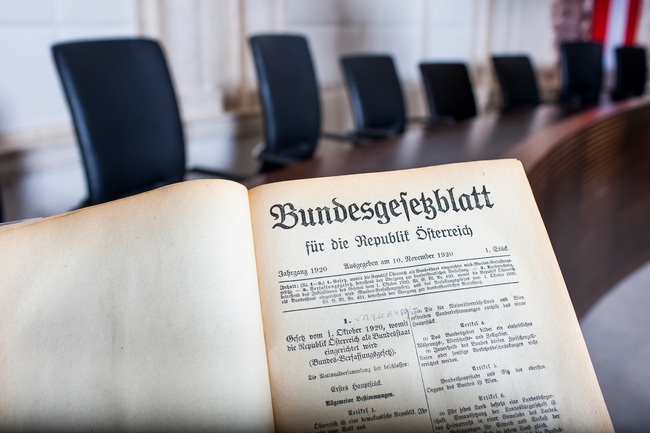January 2019: Precursor of today’s Constitutional Court established 100 years ago
One hundred years ago, on 25 January 1919, the Constitutional Court of the Republic of German-Austria was established. It first took over the functions of the former Imperial Court and then those of the State Court. It was furnished with the power to review laws, which was, however, limited to laws adopted by provincial legislative bodies. It had a president, a vice-president, eight members and four substitute members. In the same year, the numbers were increased to twelve members and six substitute members, all of them first nominated by the State Council and subsequently appointed by the President of the National Assembly upon the Government’s proposal.
25/30 January 2019: Establishment of the Constitutional Court of the Republic of German-Austria
The concept of a specialized constitutional court, endowed with the power to review laws, found its way from Austria to other countries within and beyond the European continent. This Austrian model of constitutional justice, which dates back to Hans Kelsen, gained ground step by step after the end of the First World War and the resultant breakup of the Austro-Hungarian Dual Monarchy. On 25 January 1919, the Provisional National Assembly adopted the law on the establishment of the Constitutional Court of the Republic of German-Austria. This law, based on a draft elaborated by Hans Kelsen on a mandate received from State Chancellor Karl Renner, was promulgated on 30 January 1919. By virtue of this law, the former Imperial Court of the Monarchy was transformed into a republican constitutional court. The Imperial Court of “old” Austria had already been referred to as a “constitutional court”. Its organization and the scope of its jurisdiction remained the same and its members were re-appointed, except for those who were non-Austrian nationals. The powers of the new constitutional court were extended step by step: Besides the powers taken over from the Imperial Court, i.e. decisions on pecuniary claims, decisions in conflicts of jurisdiction and the power to review violations of political rights, the new court was granted jurisdiction over supreme bodies of the state in cases of ministerial impeachment. At the time of the Monarchy, the latter was within the jurisdiction of the State Court, which had been established in 1867 (24 members elected for six years), but never exercised its functions. Moreover, on 15 March 1919, the court was furnished with the power to review laws adopted by a provincial legislative assembly upon the government’s request.
The Constitutional Court based on the Federal Constitutional Law of 1920

The Constitution (Federal Constitutional Law. B-VG), which was adopted on 1 October 1920 and entered into force on 10 November 1920, confirmed all the powers taken over by the new constitutional court set up in 1919. At the same time, the jurisdiction of the court was broadened through important innovations: the power to review the legality of regulations and the constitutionality of federal laws upon the request of a provincial government (the judicial review of provincial laws had already been within the remit of the German-Austrian Constitutional Court), the power to perform ex-officio reviews of federal and provincial laws, the power to review the lawfulness of elections, and the power to decide in cases of infringement of international law. Moreover, the provisions on the accountability of the supreme bodies of the state were extended in scope. By and large, those are the powers still exercised by the Constitutional Court today. The president, the vice-president and half of the court’s members and substitute members were elected by the National Council, whereas the other half were elected for life by the Federal Council. Members were not required to be jurists.
Hans Kelsen: The “architect” of the Constitution and the Constitutional Court
On 13 July 1921, the National Council adopted the act on the organization and the procedures of the Constitutional Court. Two days later, it elected its members, among them Professor Hans Kelsen, who had been a member of the German-Austrian Constitutional Court since May 1919. To this very day, Hans Kelsen is regarded as the “architect” of the Austrian Constitution and the Constitutional Court.
Original documents relating to the foundation of the Constitutional Court of the Republic of German-Austria can be viewed by groups upon prior registration in the foyer of the Constitutional Court on the first floor at Freyung 8, 1010 Vienna, within the framework of a permanent exhibition. For further information on guided tours and events, please visit the website of the Constitutional Court at: https://www.vfgh.gv.at/service/anlaufstellen/visitor_service_and_events.en.html
